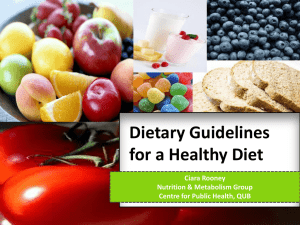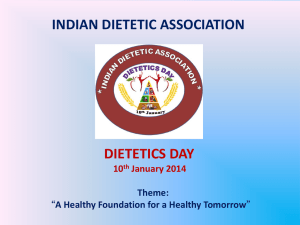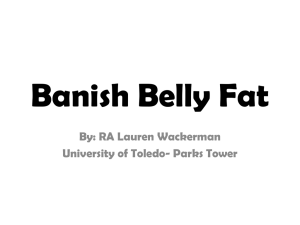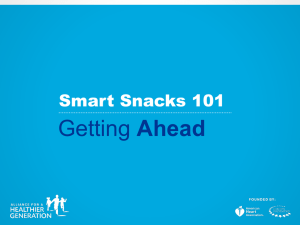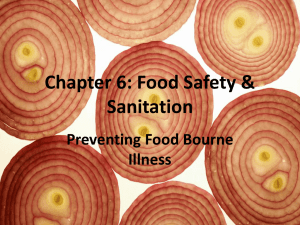RED
advertisement
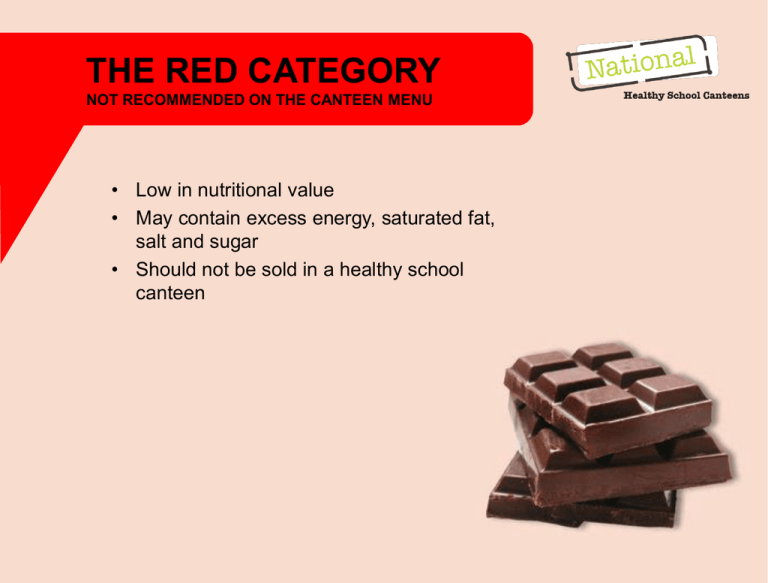
THE RED CATEGORY NOT RECOMMENDED ON THE CANTEEN MENU • Low in nutritional value • May contain excess energy, saturated fat, salt and sugar • Should not be sold in a healthy school canteen THE RED CATEGORY • Sugar sweetened drinks, soft drinks, fruit drinks, iced tea cordial, sports drinks, sports waters, flavoured mineral waters and energy drinks • Intense (artificially) sweetened foods and drinks with the exception of milk, yoghurt and custard • Products containing guarana or added caffeine. Coffee-style milk drinks may be sold in secondary school. Maximum 375mL serve size • Fruit/vegetable juice, less than 99% juice, added sugar, greater than 250mL serve size • Jelly desserts and ice crushes/slushies, less than 99% fruit, added sugar, greater than 200mL serve size • Icy-poles and fruit ice blocks, less than 99% juice, added sugar, greater than 125mL serve size THE RED CATEGORY • Iced cakes and slices, doughnuts, Danishes, croissants, cream-filled buns/cakes • All types: sold separately or added to products including; boiled lollies, carob, chocolate (including; boiled lollies, carob, chocolate (including choc chips and chocolate-coated), chocolate spreads, cough lollies, 100s and 1000s, juice jellies, icing, liquorice, soft lollies, yoghurt/carob-coated • Deep-fried foods • Cream, coconut cream, coconut milk, butter, copha, ghee and lard DECIDING IF A FOOD OR DRINK MAY BE SOLD START – p.9 Guidelines for healthy foods and drinks supplied in school canteens Does the item easily fit into the GREEN or RED category ? NO YES No further assessment necessary. Which category does the item fit into? GREEN Item may be sold GREEN Will need to be assessed • Food tables (pp. 6-8 NHSC Guidelines) • Nutrient Criteria (p. 10 NHSC Guidelines) • If it does not meet criteria the item is RED and should not be sold NO RED Item should not be sold RED YES Item may be sold AMBE R NUTRIENT CRITERIA TABLES Table 1: Hot food items and processed meats assessed per 100g Category Nutrient Criteria Energy (kJ) per 100g Saturated fat (g) per 100g Sodium (mg) per 100g Savoury pastries, filled breads, pasta dishes, pizzas, oven-baked potato products, dim sims, spring rolls, rice and noodle dishes 1000kJ or less 5g or less 400mg or less Meat products and alternatives crumbed and not-crumbed (burgers, patties, strips, balls or nuggets), sausages, frankfurts and saveloys, stews, casseroles and curries 1000kJ or less 5g or less 450mg or less Processed luncheon meats (fritz, devon, chicken loaf, free flow chicken products) and cured meats (for example: ham, bacon) 1000kJ or less 5g or less 750mg or less Table 2: Snack food items assessed per serve Category Nutrient Criteria Energy (kJ) per serve Saturated fat (g) per serve Sodium (mg) Per serve Fibre (g) per serve 600kJ or less 3g or less - 1g or more Savoury snack food, biscuits, crispbreads and crisps 600kJ or less 2g or less 200mg or less - Ice creams, milk-based ices and dairy desserts 600kJ or less Sweet snack food, bars and biscuits --(Energy must be 1800kJ or less per 100g)-3g or less - - --(Milk must be listed as first ingredient)-Un-iced cakes, muffins and sweet pastries 900kJ or less 3g or less - 1.5g or more HOW TO APPLY THE GUIDELINES STEP 1 Using the tables in the NHSC Guidelines (pp 6-8), sort the foods and drinks on the next slide into 4 groups: 1. Items categorised as GREEN 2. Items categorised as RED 3. Items categorised as AMBER 4. Items you are ‘not sure’ about. These will need to be assessed using the food and drink tables and if necessary the nutrient criteria SAMPLE MENU Sorting Foods AMBER GREEN NOT SURE RED RED GREEN GREEN NOT SURE NOT SURE GREEN RED NOT SURE RED NOT SURE NOT SURE AMBER GREEN GREEN RED NOT SURE NOT SURE ACTIVITY - HOW TO APPLY THE GUIDELINES STEP 2 Using the Nutrient Criteria Tables, assess the foods you are not sure about and determine whether these foods are categorised as AMBER or RED • The food is categorised as AMBER if all the values for: • energy, saturated fat and sodium (if applicable) are lower than the recommended value • and fibre is higher (if applicable) • The food is categorised as RED if one or more of the values for: • energy, saturated fat and sodium (if applicable) is higher than the recommended value • or fibre is lower (if applicable) NUTRIENT CRITERIA There are 2 tables for assessing AMBER foods 1. Table 1 (NHSC Guidelines, p.10) • Assess hot food items and processed meats • All foods in this category are assessed per 100g • If one criterion not met item is categorised as RED Table 1: Hot food items and processed meats assessed per 100g Category Nutrient Criteria Energy (kJ) per 100g Saturated fat (g) per 100g Sodium (mg) per 100g Savoury pastries, filled breads, pasta dishes, pizzas, oven-baked potato products, dim sims, spring rolls, rice and noodle dishes 1000kJ or less 5g or less 400mg or less Meat products and alternatives crumbed and not-crumbed (burgers, patties, strips, balls or nuggets), sausages, frankfurts and saveloys, stews, casseroles and curries 1000kJ or less 5g or less 450mg or less Processed luncheon meats (fritz, devon, chicken loaf, free flow chicken products) and cured meats (for example: ham, bacon) 1000kJ or less 5g or less 750mg or less NUTRIENT CRITERIA 1. • • • Table 2 (NHSC Guidelines, p.10) Assess snack foods. All foods in this category are assessed per serve If one criterion not met item is categorised as RED Table 2: Snack food items assessed per serve Category Nutrient Criteria Energy (kJ) per serve Saturated fat (g) per serve Sodium (mg) Per serve Fibre (g) per serve 600kJ or less 3g or less - 1g or more Savoury snack food, biscuits, crispbreads and crisps 600kJ or less 2g or less 200mg or less - Ice creams, milk-based ices and dairy desserts 600kJ or less Sweet snack food, bars and biscuits --(Energy must be 1800kJ or less per 100g)-3g or less - - --(Milk must be listed as first ingredient)-Un-iced cakes, muffins and sweet pastries 900kJ or less 3g or less - 1.5g or more EXAMPLE (NHSC Guidelines, page 12) NUTRITION INFORMATION Crumbed chicken patty 1. Identify the correct food table. 2. Find the 100g column 3. Compare the 100g serve size to criteria Servings per package: 60 Average serving size: 83g Quantity per Serving Quantity per 100g ENERGY 754kJ 909kJ PROTEIN 8.0g 9.6g FAT – total – saturated 13.0g 2.4g 15.6g 2.9g CARBOHYDRATE – sugars 6.7g 1.2g 8.1g 1.4g 256mg 308mg SODIUM Table 1: Hot food items and processed meats assessed per 100g Category Nutrient Criteria Energy (kJ) per 100g Saturated fat (g) per 100g Sodium (mg) per 100g Savoury pastries, filled breads, pasta dishes, pizzas, oven-baked potato products, dim sims, spring rolls, rice and noodle dishes 1000kJ or less 5g or less 400mg or less Meat products and alternatives crumbed and not-crumbed (burgers, patties, strips, balls or nuggets), sausages, frankfurts and saveloys, stews, casseroles and curries 1000kJ or less 5g or less 450mg or less Processed luncheon meats (fritz, devon, chicken loaf, free flow chicken products) and cured meats (for example: ham, bacon) 1000kJ or less 5g or less 750mg or less GREEN, AMBER OR RED? Reduced-fat Milk Servings per package: 1 Average serving size: 250g Quantity per Serving Quantity per 100g ENERGY 500kJ 263kJ PROTEIN 10.0g 3.9g FAT – total – saturated 2.5g 1.3g 1.0g 0.5g CARBOHYDRATE – sugars 15g 14.8g 6.0g 5.9g SODIUM 135mg 54mg GREEN, AMBER OR RED? Banana flavoured milk-based ice Ingredients: Reconstituted skim milk (70%), cane sugar, glucose syrup, vegetable oil, milk solids, maltodextrin, gelatine, emulsifier (471), flavours, colours (160b, 100) Servings per package: 8 Average serving size: 68g Quantity per Serving Quantity per 100g ENERGY 462kJ 680kJ PROTEIN 2.3g 3.4g FAT – total – saturated 3.6g 1.8g 5.3g 2.7g CARBOHYDRATE – sugars 16.9g 13.4g 24.8g 19.7g SODIUM 31mg 46mg Table 2: Snack food items assessed per serve Category Nutrient Criteria Energy (kJ) per serve Saturated fat (g) per serve Sodium (mg) Per serve Fibre (g) per serve 600kJ or less 3g or less - 1g or more Savoury snack food, biscuits, crispbreads and crisps 600kJ or less 2g or less 200mg or less - Ice creams, milk-based ices and dairy desserts 600kJ or less Sweet snack food, bars and biscuits --(Energy must be 1800kJ or less per 100g)-3g or less - - --(Milk must be listed as first ingredient)-Un-iced cakes, muffins and sweet pastries 900kJ or less 3g or less - 1.5g or more GREEN, AMBER OR RED? Fruit and Muesli Breakfast Bar Servings per package: 12 Average serving size: 13.3g Quantity per Serving Quantity per 100g ENERGY 770kJ 1710kJ PROTEIN 3.7g 8.3g FAT – total – saturated 6.9g 0.7g 15.3g 1.6g CARBOHYDRATE – sugars 24.4g 9.0g 54.3g 19.9g FIBRE 4.3g 0.6g SODIUM 14mg 30mg Table 2: Snack food items assessed per serve Category Nutrient Criteria Energy (kJ) per serve Saturated fat (g) per serve Sodium (mg) Per serve Fibre (g) per serve 600kJ or less 3g or less - 1g or more Savoury snack food, biscuits, crispbreads and crisps 600kJ or less 2g or less 200mg or less - Ice creams, milk-based ices and dairy desserts 600kJ or less Sweet snack food, bars and biscuits --(Energy must be 1800kJ or less per 100g)-3g or less - - --(Milk must be listed as first ingredient)-Un-iced cakes, muffins and sweet pastries 900kJ or less 3g or less - 1.5g or more GREEN, AMBER OR RED? Doughnuts Servings per package: 6 Average serving size: 40g Quantity per Serving Quantity per 100g ENERGY 951kJ 1510kJ PROTEIN 2.9g 4.6g FAT – total – saturated 7.9g 3.8g 12.5g 6g CARBOHYDRATE – sugars 35.3g 19.9g 56g 31.6g SODIUM 289mg 458mg GREEN, AMBER OR RED? Meat Pie Servings per package: 60 Average serving size: 83g Quantity per Serving Quantity per 100g ENERGY 1600kJ 890kJ PROTEIN 15.0g 8.4g FAT – total – saturated 15.4g 7.4g 8.5g 4.1g CARBOHYDRATE – sugars 43.3g <1g 24.3g <1g SODIUM 418mg 232mg Table 1: Hot food items and processed meats assessed per 100g Category Nutrient Criteria Energy (kJ) per 100g Saturated fat (g) per 100g Sodium (mg) per 100g Savoury pastries, filled breads, pasta dishes, pizzas, oven-baked potato products, dim sims, spring rolls, rice and noodle dishes 1000kJ or less 5g or less 400mg or less Meat products and alternatives crumbed and not-crumbed (burgers, patties, strips, balls or nuggets), sausages, frankfurts and saveloys, stews, casseroles and curries 1000kJ or less 5g or less 450mg or less Processed luncheon meats (fritz, devon, chicken loaf, free flow chicken products) and cured meats (for example: ham, bacon) 1000kJ or less 5g or less 750mg or less ACTIVITY (Workbook, P.14) Look at the nutrition information panels provided. Do these examples meet the NHSC AMBER nutrient criteria? Should they be sold through the canteen? MOVING AMBER FOODS TOWARDS THE GREEN END OF THE SPECTRUM MOVING AMBER FOODS TOWARDS THE GREEN END OF THE SPECTRUM STEP 3 AMBER foods and drinks can be made healthier and moved towards the ‘GREEN’ end of the spectrum by: • Serving main meal items with salad or vegetables (and a lean protein source where appropriate) • Serving snack foods with fruit and vegetables where possible • dips with vegetable sticks • reduced-fat custard with fruit • Keeping the serve size small • Serving with a small amount of low or reduced-fat or low or reduced-salt condiments (if any are to be used at all) • Comparing products using information on labels • Choosing healthier alternatives where possible (Table 3). MAKING A HEALTHIER CHOICE Tomato, vegetable and pasta soup Canned tomato, vegetable and pasta soup Servings per package: 2 Average serving size: 250g Quantity per Serving Quantity per 100g ENERGY 392kJ 157kJ PROTEIN 4.5g 1.8g FAT – total – saturated 0.5g <0.1g 0.2g <0.1g CARBOHYDRATE – sugars 17.5g 4.0g 7.0g <1.6g SODIUM 725mg 290mg Table 3: Healthier choices assessed per 100g Category Nutrient Criteria Saturated fat (g) per 100g Sodium (mg) per 100g Fibre (g) per 100g Sugar (mg) per 100g Breakfast cereals not containing dried fruit 2g or less – 5g or more 20g or less Breakfast cereals containing dried fruit 2g or less – 5g or more 20g or less Pasta sauces and simmer sauces 2g or less 300mg or less – – Soups as prepared ready-to-eat (condensed, instant) 2g or less 300mg or less – – Dips (legume, dairy, vegetable or salsa) 2g or less 75mg or less – – Mayonnaise and salad dressings 2g or less 750mg or less – – ACTIVITY (Workbook, P.14) Look at the nutrition information panels provided. Do these examples meet the ‘making a healthier choice’ nutrient criteria? MOVING AMBER FOODS TOWARDS THE GREEN END OF THE SPECTRUM Using the examples below, ‘GREEN’ these AMBER menu items. (Workbook, P.14) Meals Snacks • Hamburger • Lasagne • Tomato soup and bread roll • Pizza • Sushi • Muffins /slices • Reduced-fat ice cream • Garlic bread MOVING AMBER FOODS TOWARDS THE GREEN END OF THE SPECTRUM Group Discussion How can you reduce the sodium content of dishes? (Workbook, P.14) FOOD PREPARATION AND COOKING METHODS • Trim visible fat • Fresh, undamaged fruit and vegetables • Minimise vitamin C loss • • • • Steaming Frying/stir frying Baking/roasting Microwaving EXAMPLE MENU How do you incorporate variety into your canteen menu? How can students be included in decisions regarding the school canteen menu? (Workbook, pp. 15-161)) SPECIAL DIETARY AND CULTURAL NEEDS • Allergies / food intolerances /sensitivities • Cultural and religious considerations SPECIAL DIETARY NEEDS Food Allergies An immune response to protein found in common foods • Any amount will cause a reaction • Reaction usually occurs within 30 minutes and can be life threatening (anaphylaxis) • Epi-pen and action plan signed by doctor • Strict avoidance is extremely important Food intolerance Sensitivity to the chemicals found in food • Naturally occurring or added in manufacturing • Small amounts may be tolerated • Reaction can take several days to appear • Diet modified to keep intake below threshold tolerated SPECIAL DIETARY NEEDS Most common food (protein) allergens: • • • • • • • • Peanuts (1 in 50 children) Tree nuts (for example; cashews, walnuts) Shellfish and fish Milk Eggs Sesame Soy Wheat SPECIAL DIETARY NEEDS Coeliac disease – gluten intolerance • 1 in 100 people • Products containing wheat, oats, rye, barley and triticale • Damages the lining of the gut • Impairs ability to absorb nutrients • Cross-contamination • Strict avoidance is extremely important Lactose intolerance • The ‘sugar’ found in milk • Lack of the enzyme ‘lactase’ • Small amounts may be tolerated • 5% Caucasian and up to 75% non-Caucasian living in Australia • Diet modified to keep intake below threshold tolerated SPECIAL DIETARY NEEDS Role of the school canteen What do you think the role of the school canteen is in regards to special dietary needs? (Workbook, p.17) SPECIAL DIETARY NEEDS Role of the school canteen Be aware of and adhere to any school policies. • For example, remove products containing nuts. You may choose to stock certain foods if practical and if there is sufficient demand. • For example, use soy milk as an alternative to regular milk. There is no clear role of the canteen or the canteen manager beyond these steps. ACKNOWLEDGING CULTURAL DIFFERENCES How many different cultures are represented at your school? Does your canteen menu cater for different cultures? Why should you do this? (Workbook, p.17) CULTURAL AND RELIGIOUS NEEDS Cultural needs • Indigenous Australians and Torres Straight Islanders • Asian • Indian • Middle Eastern • South European • African Religious needs • Buddhism • Hinduism • Islamic • Judaism • Christianity CATERING FOR CULTURAL AND RELIGIOUS NEEDS In schools with large ethnic populations • Have 1 or 2 culturally appropriate items/dishes on the menu where possible In schools with smaller numbers of culturally diverse groups • Have special ‘ethnic’ days • Recognise and honour other cultures • For example: Asian, Indian, Middle Eastern and South European What foods could you cook on these days? (Workbook, p.17) LOOKING AFTER OUR PLANET Wherever possible, use seasonal produce Support local producers School gardens • Stephanie Alexander Kitchen Garden Foundation http://www.kitchengardenfoundation.org.au Where the range of fresh foods is insufficient, use frozen and canned produce. SUMMARY Basic understanding of: • Nutrition • The nutritional basis of the NHSC Guidelines How to apply the NHSC Guidelines using: • General principles of healthy eating • Food label reading skills Materials to take away: • Guidelines for healthy foods and drinks supplied in school canteens • Quick Reference • Poster (Healthy kids need healthy canteens!) • Food Safety Fact Sheet • The Australian Guide to Healthy Eating poster • Healthy Eating for Children brochure FURTHER STUDY Workplace Implementation Project • Website links for further reading • Nutritional Panel Calculator • Costing tool Statement of Attainment Issued by Registered Training Provider • SITHCCC035A Develop menus to meet special dietary and cultural needs • Cert III in Hospitality(Catering Operations), (Commercial Cookery) • Cert IV in Hospitality (Commercial Cookery) Training.gov.au (TGA) database on Vocational Education and Training (VET) in Australia http://www.training.gov.au Additional information on the 2013 Australian Dietary Guidelines: www.eatforhealth.gov.au Thank You QUESTIONS?
